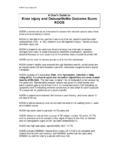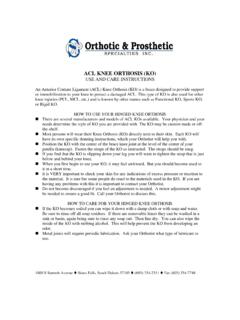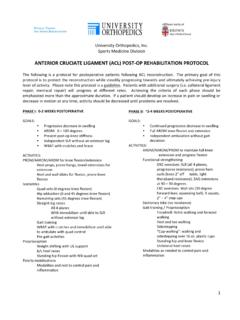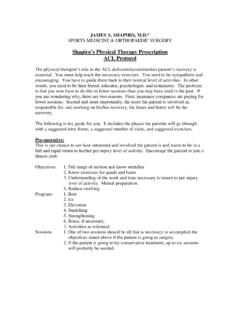Transcription of KNEE REPLACEMENT SURGERY FOR THE RECREATIONAL …
1 Richard A. Sweet, Louisville Orthopaedic Clinic Louisville, KY knee REPLACEMENT SURGERY FOR THE RECREATIONAL ATHLETE INTRODUCTION: In the early development of knee REPLACEMENT SURGERY , the goal of the procedure was to provide a knee that allowed an elderly patient disabled with arthritis of the knee to walk comfortably for the purpose of pursuing activities of daily living. Over the last three decades, these modest goals have dramatically changed. As the knees and hips of active baby boomers start to show signs of arthritic wear and tear, solutions have been sought to allow them to maintain their active lifestyles.
2 Implant manufactures have developed knee replacements with improved function and durability. Surgeons have improved knee REPLACEMENT operative techniques. The result is that it is now possible for patients receiving knee (and hip) replacements to lead active lifestyles and to continue participation in RECREATIONAL sports and relatively vigorous exercise programs. LIGAMENT ISSUES IN TKR SURGERY FOR THE ATHLETIC PATIENT Unique challenges are faced by the surgeon in providing a knee that will respond to peak demands of athletics. These include: 1. LOSS OF THE ANTERIOR CRUCIATE LIGAMENT (ACL): In all total knee REPLACEMENT designs, the anterior cruciate ligament (ACL) is sacrificed.
3 Loss of the ACL creates the potential for post op knee ligament laxity. This laxity can make participating in RECREATIONAL sports, exercise programs and aggressive daily / work activities difficult. 2. MAINTAINANCE OF PERFECT POSTERIOR CRUCIATE LIGAMENT (PCL) FUNCTION: Posterior knee stability (prevention of the tibia from sliding back under the femur) is crucial to the function of the knee in all active knee REPLACEMENT patients. Maintaining ideal posterior stability is the cornerstone of the REPLACEMENT surgical strategy. In the normal knee the PCL (located in the center back of the knee ) performs this function.
4 Posterior stability is critical for daily / work activities such as going up and down stairs, climbing, stooping and kneeling. Proper PCL funtion is also essential for athletic movements such as jumping, pivoting and quick stopping and starting. As opposed to the ACL, the PCL does not necessarily have to be removed in knee REPLACEMENT SURGERY . Implant designs that preserve the PCL are called Posterior Cruciate Ligament Retaining implants. Those that sacrifice the PCL are called Posterior Cruciate Ligament Sacrificing implants. There are advantages and disadvantages to each design.
5 In PCL Retaining implants, stability is dependent on the surgeon s experience and skill in properly preserving, tensioning and balancing the PCL. In PCL Sacrificing implants, posterior stability is an inherent part of the design of the implant but at the cost of sacrificing / removing more bone from the femur and possibly placing more stress on the cement bond of the implants to the bone. FIGURE 1. LIGAMENTS OF THE NORMAL knee : The Medial & Lateral Collateral ligaments (yellow arrows) of the knee must be balanced. The ACL (red arrow) is always sacrificed in TKR SURGERY .
6 The PCL (blue arrow) may be sacrificed or preserved. FIGURE 2. PCL SACRIFICING TKR: The PCL Sacrificing Implant removes more bone in the center of the femur. The plastic tibial insert has a post (yellow arrows) that abuts against the posterior metal bar (red arrow) of the femoral implant to provide posterior stability. SURGICAL GOALS IN THE RECREATIONAL ATHLETE In order for a patient with a knee REPLACEMENT to be able to participate in RECREATIONAL sporting activities the following must occur: 1. ANATOMY RESTORED: The knee REPLACEMENT implants must be anatomically positioned on the femur, tibia, and patella three dimensionally to restore proper overall leg alignment.
7 2. COLLATERAL LIGAMENTS BALANCED: The medial and lateral collateral ligaments on the inside and outside of the knee must be evenly balanced to provide side-to-side stability to the knee . In the process, preoperative mal-alignment such as a bowed or knock-kneed deformity must be corrected. 3. POSTERIOR STABILITY ACHIEVED: As noted above, posterior stability of the tibia on the femur must be achieved by either preserving the PCL or by substituting for it with a PCL sacrificing implant design. RAPID RECOVERY TIMELINE FOR THE ATHLETIC PATIENT IMPROVEMENTS IN REHAB TIMELINE DUE TO: 1.
8 The Quadriceps Sparing or Minimally Invasive surgical approach avoids cutting into the quadriceps muscle. Operative protection of the quad muscle has allowed for the return of early quadriceps function to the point where many patients can perform a straight leg raise immediately after the effects of the numbing blocks have subsided. 2. Better initial pain management (the most effective of which are the use of femoral and sciatic nerve blocks to numb the leg for 12 24 hours post op) allows for more effective early therapy. FIGURE 3. QUADRICEPS SPARING MINIMALLY INVASIVE SURGERY : The YELLOW line represents the deep incision (not the skin incision) common to all surgical approaches of the knee .
9 The GREEN proximal extension of this yellow line represents the standard surgical approach into the joint that cuts into the quadriceps tendon and muscle. Cutting into the quad tendon and muscle in this manner delays healing and slows rehab. The BLUE extension of the incision represents the Quadriceps Sparing Minimally Invasive approach that allows for immediate return of quadriceps function speeding rehab for the athletic patient. RECOVERY TIMELINE FOR THE ATHLETIC PATIENT: 1. Hospital stay: 2 3 nights. 2. CPM machine for early motion used night of SURGERY .
10 3. Twice-daily in-hospital therapy starts the day after SURGERY . 4. Full weight bearing is allowed as soon as the effects of the sciatic and femoral nerve blocks (administered pre-operatively as a part of the initial pain management program) have receded. 5. Patients are permitted to get off the walker / crutches as soon as tolerated. In the athlete this usually occurs in less than 1 2 weeks. 6. Physical therapy (home and outpatient) is required for 4 6 weeks post operatively. 7. Independent exercise program to maintain quad & hamstring strength recommended indefinitely.









